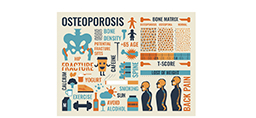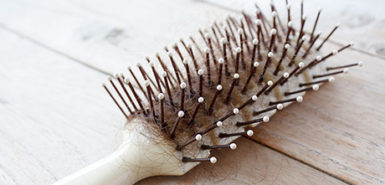
One in 3 women and 1 in 5 men older than 50 will experience an osteoporosis-related fracture.
Hip fractures often require surgery and may lead to loss of independence, and vertebral fractures lead to loss of height, pain, nerve compression, and sometimes deformity.
A bit about bones
Our bones are constantly remodeling, with steady building and breakdown, and we reach a peak bone mass in our late 20s.
After our peak, we lose a bit more each year than we build, and when the bones get to be too porous and weak, we are at risk for a fragility fracture, or a break that occurs with minimal trauma such as stepping wrong off a curb or a low-impact fall.
Osteoporosis is the condition when the bones are thin enough to increase risk of fracture to the point that treatment might be indicated, and our goal is to keep osteoporosis from happening.
Osteoporosis is a silent disease, and has no symptoms. The good news is osteoporosis can be prevented, and also predicted if you know the risks.
The basic concept is we want to support our bone-building cells by supplying adequate calcium in our diet. This includes four servings of dairy or leafy greens, adequate vitamin D to allow for calcium absorption (about 2000 IU per day for most adults), and enough weight-bearing activity to let the bones know they are needed. Research shows we need approximately 20 minutes of weight-bearing activity per day.
Midlife wellness
As a busy obstetrician and gynecologist, I should have been thinking about my patient’s bone health way more than I did, but it was not on my radar for those years of delivering babies.
As I started to care more for women approaching midlife and thinking about how I could support wellness, I started asking my patients about risk factors.
I soon met Jeffry Knibbe, MD, an internal medicine physician who is passionate about bone health and supports our patients on how to avoid fracture and disability. He taught me about prevention, diagnosis and treatment options.
Also at that time, I had a patient who underwent a bone scan and, when I called her with the bad news that she had osteoporosis, she felt absolutely floored. How could she, a healthy 52-year-old, have osteoporosis?
We went through the risk factors, and she probably never took enough D like the rest of us, avoided dairy due to lactose intolerance, was active but perhaps not enough, and occasionally took oral steroids for asthma.
She decided to start hormone replacement therapy for her menopause symptoms, which is also indicated for prevention of osteoporosis as it supports the good bone she still had. She also became serious about vitamin D and calcium supplements, and exercised every day or at least did her 50 jumps.
A followup scan three years later showed stable bones. Further, her fitness regimen had improved her balance so she was less likely to fall. Thank goodness we found her osteoporosis before she had a fracture.
Supporting your skeleton
We support bone health by knowing what risk factors to avoid. If we have other health conditions that put our bones at risk, we should be aware of the issues and do what we can to make up for the risk.
Lifestyle risk factors for osteoporosis include more than two alcohol drinks per day, cigarette smoking, inactivity, low body weight, and inadequate calcium and vitamin D.
Genetic factors for osteoporosis include family history and conditions such as cystic fibrosis and other metabolic conditions. Hormone conditions— such as menopause, especially if premature, diabetes, Cushing disease and parathyroid dysfunction—are also factors.
Medical conditions such as anorexia and bulimia also put people at risk, as well as celiac disease, epilepsy, rheumatoid arthritis, gastric bypass surgery and lupus. Many cancers also put people at risk for accelerated bone loss such as multiple myeloma, treatments for breast cancer, and medication use to include oral steroids, antacids and anti-seizure medication.
The good news is, if we look, we can get information in time to act and help slow or prevent bone loss. The results from a scan, together with risk factors, help us make recommendations for potential treatment.
 /a>
/a>
 /a>
/a>
 /a>
/a>
Found this article VERY helpful. Spectrum needs to provide bone care specialists like Dr. Knibbe.
Hi Sherry – So glad you found this article helpful! Luckily, Spectrum Health has great physicians, such as Dr. Knibbe, who are passionate about bone care. If you’d like to schedule an appointment with Dr. Knibbe or his associates, check out this Find a Doctor link: https://findadoctor.spectrumhealth.org/physician/profile/1566 and best wishes to you!